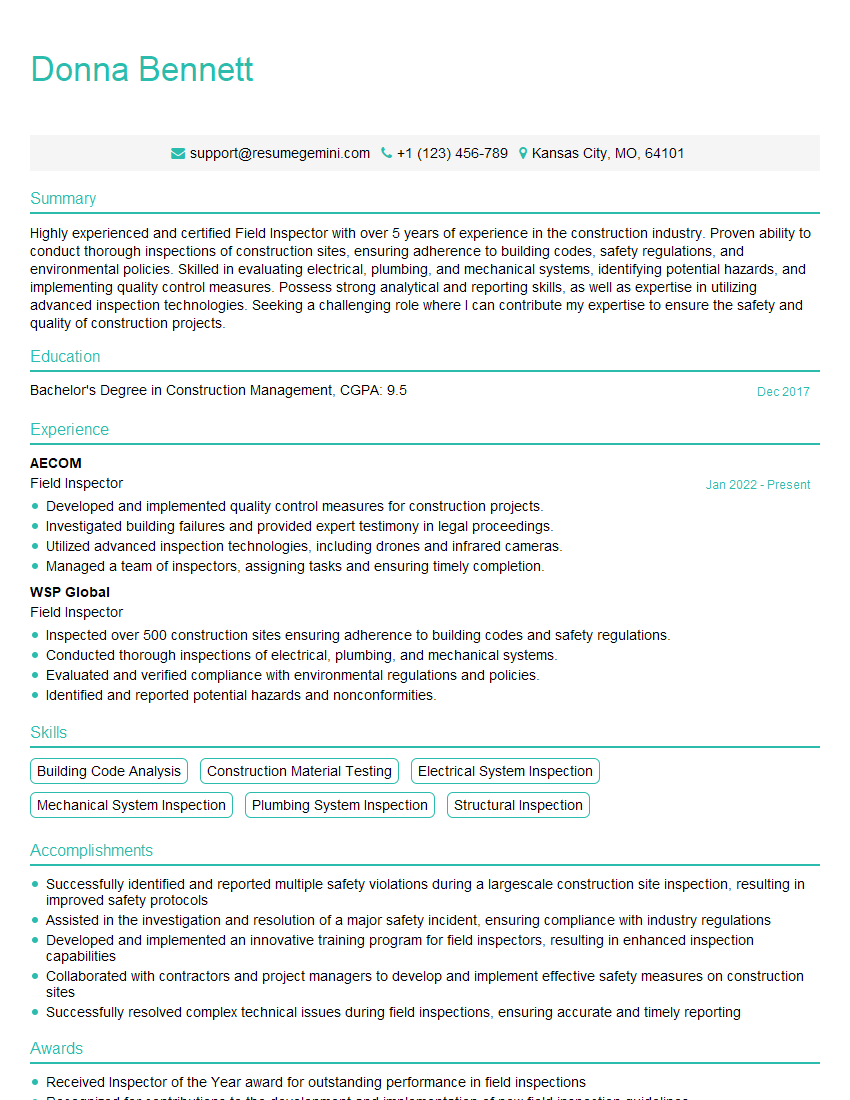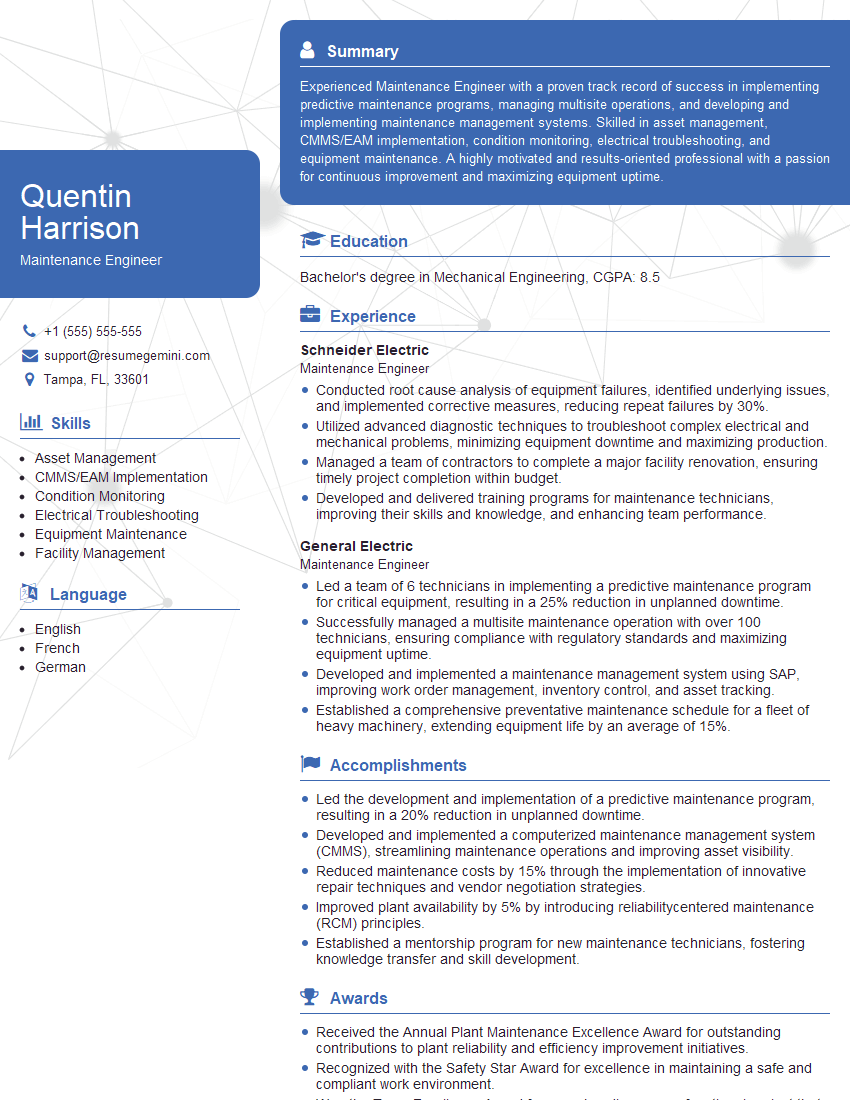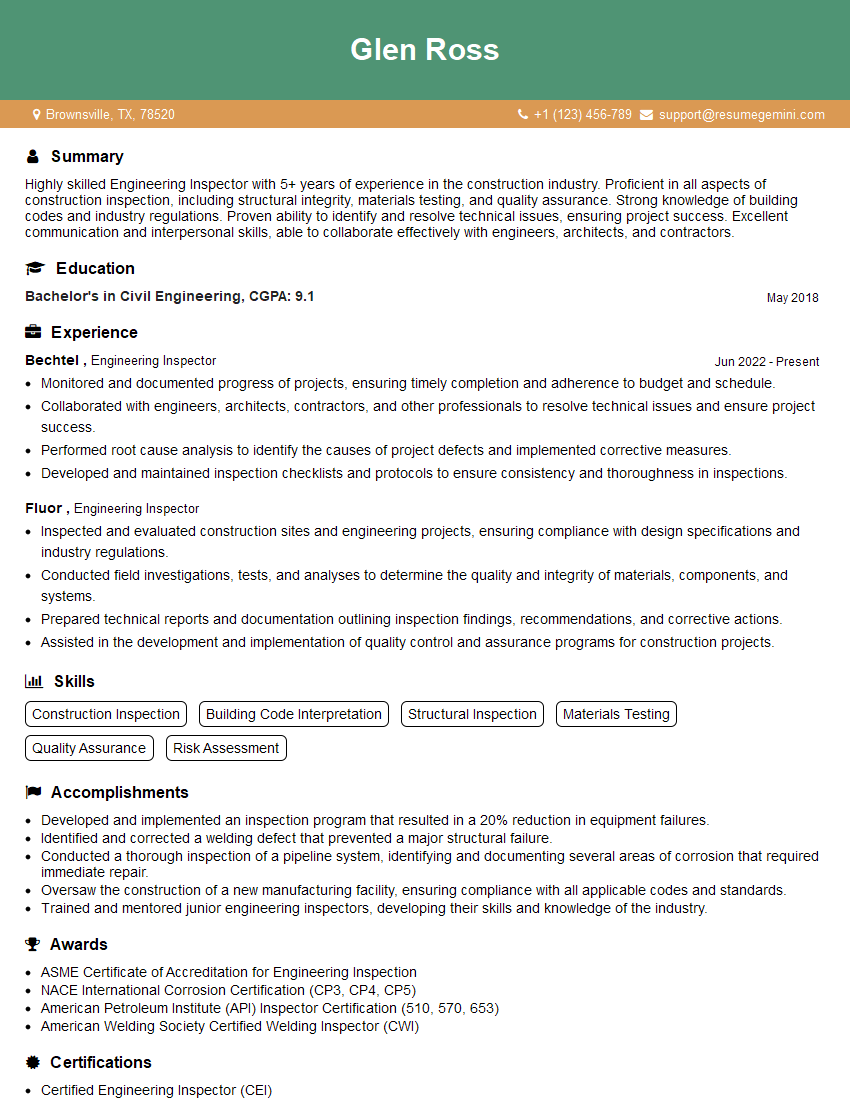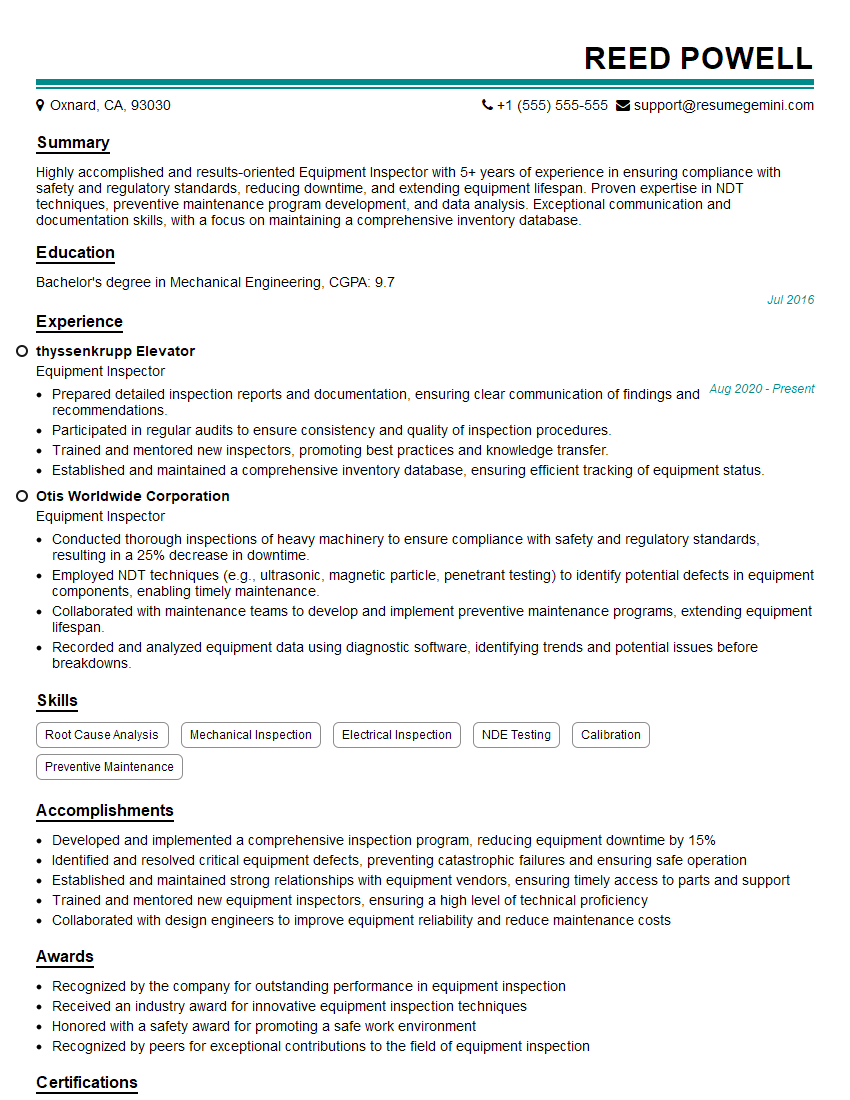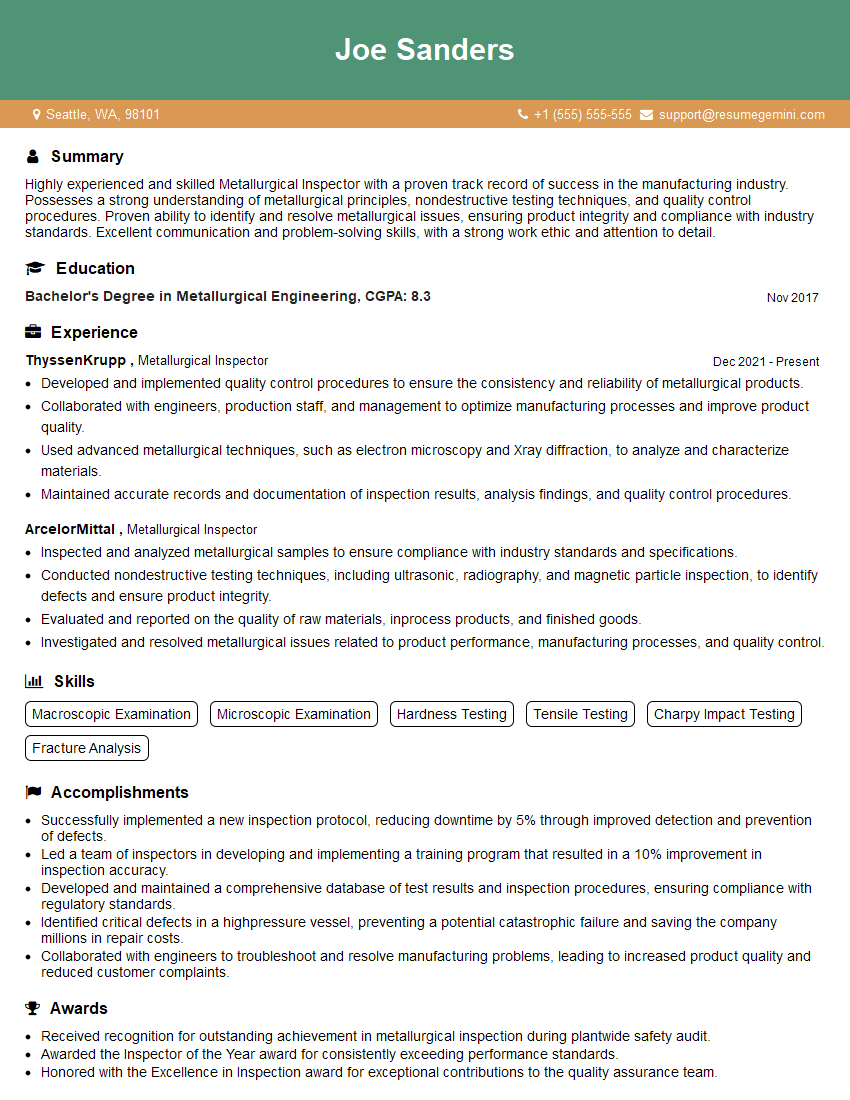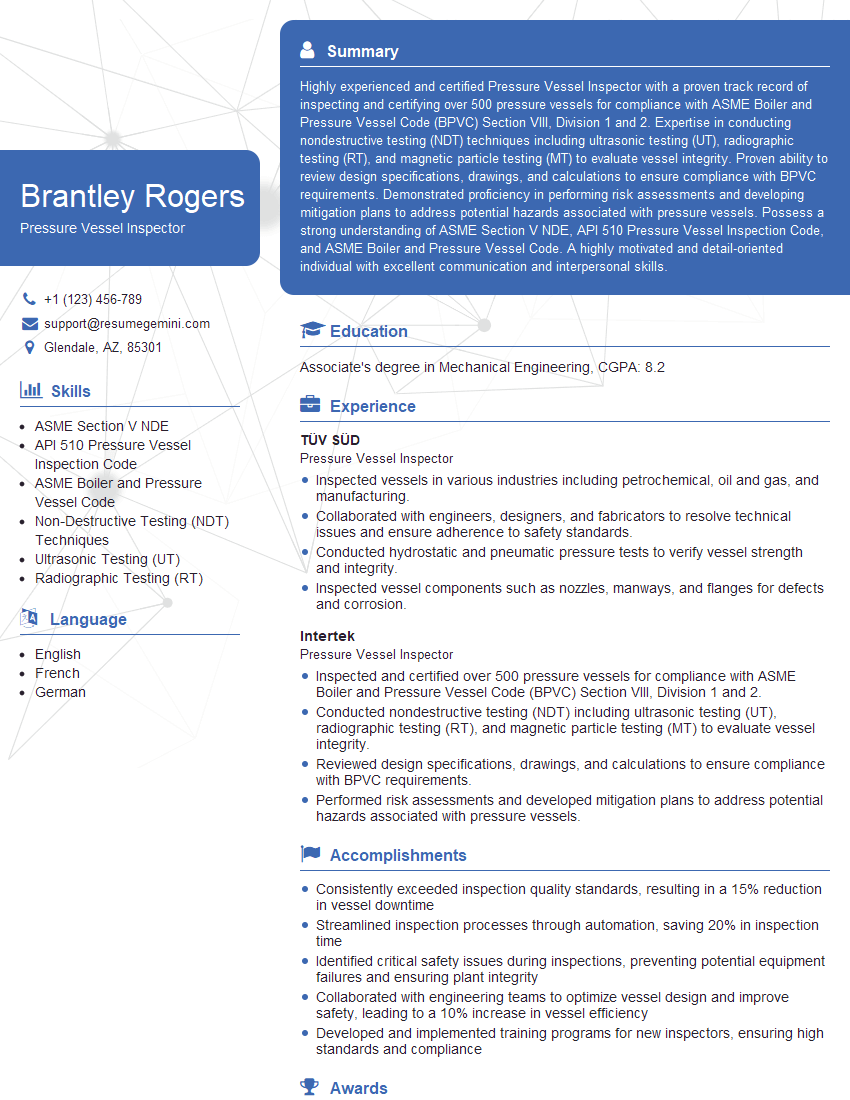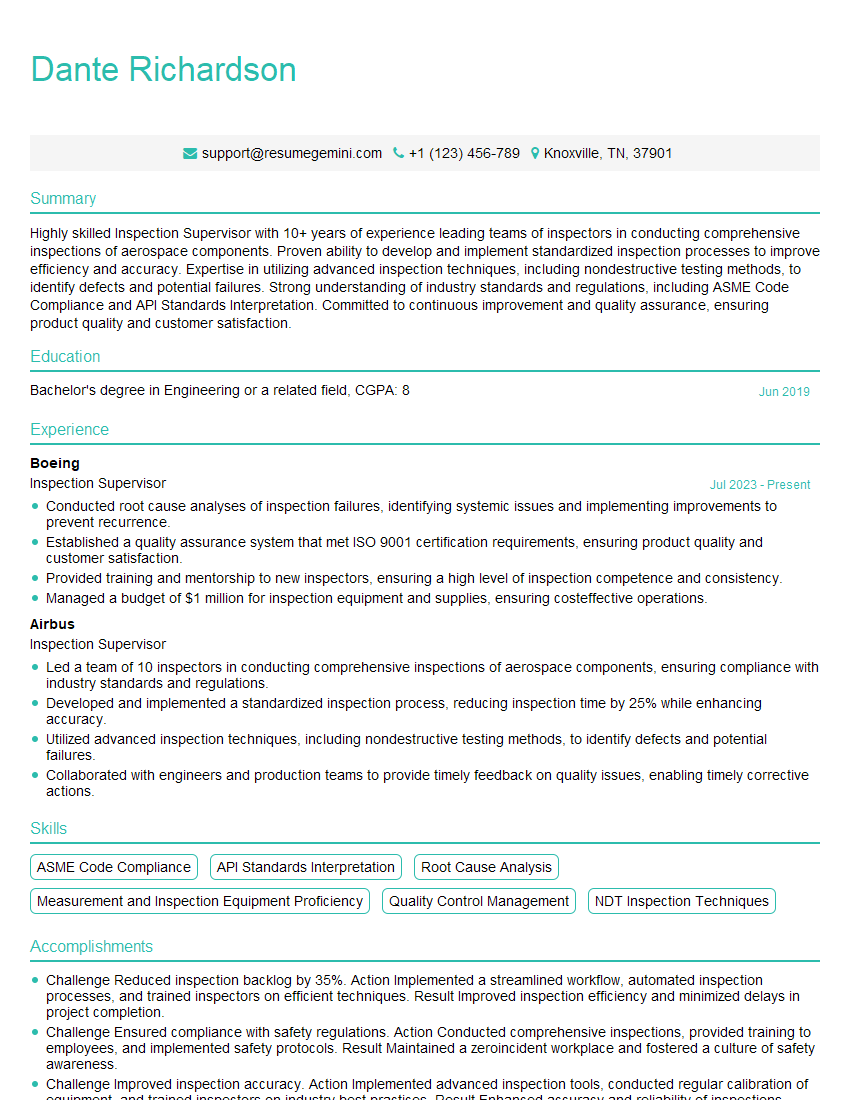Interviews are more than just a Q&A session—they’re a chance to prove your worth. This blog dives into essential API 570 Inspection interview questions and expert tips to help you align your answers with what hiring managers are looking for. Start preparing to shine!
Questions Asked in API 570 Inspection Interview
Q 1. Explain the scope of API 570.
API 570, “Inspection, Repair, Alteration, and Rerating of Pressure Vessels,” sets the standard for the inspection and maintenance of pressure vessels in various industries. Its scope encompasses the entire lifecycle of a pressure vessel, from initial design review and fabrication assessment to ongoing in-service inspection, repair, alteration, and potential rerating. Essentially, it provides a comprehensive framework for ensuring the continued safe operation of these critical components. This includes establishing criteria for initial inspections before a vessel goes into service, defining inspection intervals and methods during operation, and guiding decision-making processes for repairs or alterations.
Think of it like a comprehensive health check for your pressure vessel. API 570 outlines the necessary examinations to identify potential problems, guide repair actions, and extend the operational life of the vessel safely.
Q 2. Describe the different types of inspections covered by API 570.
API 570 covers a range of inspection types, each tailored to different aspects of pressure vessel integrity. These include:
- Visual Inspections: These are the most basic, involving a thorough visual examination of the vessel’s exterior and interior (when accessible) to identify any obvious damage, such as corrosion, dents, or cracks.
- Non-Destructive Examinations (NDE): This encompasses a wider array of techniques, including radiography (X-ray), ultrasonic testing (UT), magnetic particle testing (MT), and liquid penetrant testing (PT), to detect internal flaws or defects that aren’t visible to the naked eye.
- Thickness Measurements: These are crucial for assessing material degradation due to corrosion or erosion. They can involve manual or automated techniques to measure the remaining wall thickness at various locations on the vessel.
- Hydrostatic Testing: Involves filling the vessel with water and pressurizing it to check for leaks and to verify the structural integrity of the vessel. This is usually part of a more extensive inspection.
- Documentation Review: This involves a careful review of the vessel’s design specifications, operating history, previous inspection reports, and any relevant maintenance records. This allows for identification of potential issues and trends over time.
The specific inspection methods and frequencies are determined based on several factors, including the vessel’s operating conditions, history, and material properties.
Q 3. What are the key differences between API 510 and API 570?
While both API 510 and API 570 deal with pressure vessels, they have distinct focuses. API 510, “Pressure Vessel Inspection Code: Maintenance, Inspection, Rating, Repair, and Alteration,” focuses more on the design and construction aspects of pressure vessels, often used during the initial fabrication and acceptance. It provides guidance for establishing the vessel’s design criteria and ensuring its compliance with industry standards. API 570, on the other hand, is primarily concerned with the in-service inspection, repair, alteration, and rerating of already existing pressure vessels. It helps ensure the ongoing safety and reliability of these vessels throughout their operational life.
To illustrate, imagine building a house (API 510 guides the construction), then regularly inspecting and maintaining it for decades (API 570 guides this ongoing process).
Q 4. How do you determine the inspection frequency for a pressure vessel according to API 570?
Determining the inspection frequency for a pressure vessel according to API 570 is not a simple matter of applying a fixed schedule. It’s a risk-based approach that considers several crucial factors. The API 570 recommends a risk assessment to decide the appropriate inspection frequency. The inspection frequency is determined by considering the vessel’s:
- Operating Conditions: High temperatures, pressures, or corrosive environments necessitate more frequent inspections.
- Material Properties: The material’s susceptibility to corrosion, degradation, or cracking influences the inspection interval. For instance, a vessel made of carbon steel in a corrosive environment will require more frequent inspection than a stainless steel vessel in a less aggressive environment.
- Operating History: A vessel with a history of repairs or incidents might require more frequent inspections than one with a clean history.
- Inspection Results: Previous inspection findings significantly impact the frequency of future inspections. If a previous inspection revealed significant corrosion or other issues, the next inspection will likely be scheduled sooner.
- Risk Assessment Results: API 570 emphasizes risk-based inspection. A comprehensive risk assessment, which considers all the above, will determine the appropriate inspection frequency, balancing cost and safety considerations.
In essence, the frequency is not prescribed but rather tailored to the specific vessel and its context. An inspection program might have various frequencies for different aspects of the inspection (e.g., external visual inspection every year, internal inspection every 5 years, NDT every 10 years).
Q 5. Explain the importance of risk-based inspection in API 570.
Risk-based inspection (RBI) is the cornerstone of API 570. It moves away from rigid, time-based inspection schedules towards a more proactive and cost-effective approach. Instead of inspecting everything at fixed intervals, RBI prioritizes components and areas posing the highest risk of failure. This involves identifying potential failure mechanisms, assessing their likelihood and consequences, and allocating inspection resources accordingly. This approach maximizes safety by focusing on the most critical areas while minimizing unnecessary inspections and costs.
Consider a scenario where a pressure vessel has areas of known localized corrosion. RBI would direct more frequent and thorough inspections of these areas, while less critical areas may be inspected less frequently. This contrasts with a fixed-schedule approach that would inspect all areas at the same interval, irrespective of their actual risk levels. The goal is optimized safety and reduced maintenance costs without compromising safety.
Q 6. What are the common causes of pressure vessel failures?
Pressure vessel failures can stem from various causes, broadly categorized as:
- Material Degradation: Corrosion (various types), erosion, and creep are major contributors to material weakening.
- Design Flaws: Incorrect design calculations, inadequate material selection, or manufacturing defects can lead to structural weaknesses.
- Fabrication Defects: Poor welding techniques, improper heat treatment, or inconsistencies in material composition can create stress concentrations and potential failure points.
- Operating Errors: Overpressurization, exceeding temperature limits, or improper operation can overload the vessel and cause failure.
- External Factors: External impacts, fires, or environmental conditions can also contribute to vessel failure.
- Corrosion Under Insulation (CUI): This is a particularly insidious form of corrosion and can lead to significant material loss without being easily detected.
A combination of these factors often contributes to a failure. For example, a design flaw might be exacerbated by material degradation due to corrosion, leading to a catastrophic event. Understanding these potential causes and implementing appropriate preventative measures is critical for maintaining safe operation.
Q 7. Describe the different types of corrosion that can affect pressure vessels.
Several types of corrosion can impact pressure vessels, each with its own characteristics and implications:
- Uniform Corrosion: This is a relatively predictable type of corrosion where the material degrades uniformly across its surface. While it can be easily monitored through thickness measurements, significant loss of material can occur.
- Pitting Corrosion: Characterized by localized attack, forming small pits or holes in the material’s surface. These pits can significantly reduce the vessel’s strength, even if the overall material loss is relatively small.
- Crevice Corrosion: Occurs in confined spaces, such as crevices or joints, where stagnant solutions can accumulate and become highly corrosive.
- Stress Corrosion Cracking (SCC): A combination of tensile stress and corrosive environment that leads to cracking of the material. This is often unpredictable and dangerous.
- Erosion Corrosion: A combined effect of erosion and corrosion. High-velocity fluids can erode the protective layer of the material, leaving it vulnerable to corrosion.
- Corrosion Fatigue: Fatigue failure that occurs in a corrosive environment. The corrosive medium accelerates the cracking process.
Identifying the specific type of corrosion affecting a pressure vessel is crucial for implementing appropriate mitigation strategies and ensuring continued safe operation. Specialized NDE techniques are often required to detect and assess different types of corrosion.
Q 8. How do you identify and assess corrosion damage during an API 570 inspection?
Identifying and assessing corrosion damage during an API 570 inspection is a crucial step in ensuring pressure vessel integrity. It involves a combination of visual inspection, detailed measurements, and potentially Non-Destructive Examination (NDE) techniques. We start with a thorough visual examination, looking for signs like pitting, uniform thinning, cracking, and crevice corrosion. The location, size, and depth of the corrosion are meticulously documented using various tools, including calibrated depth gauges and rulers. For example, we might find pitting corrosion on the inside of a storage tank’s bottom. Measuring the depth of the deepest pits using a calibrated probe is essential. If uniform thinning is observed, we’ll carefully measure the wall thickness at multiple points to determine the extent of material loss. This data is crucial for determining the remaining life and the need for repairs or replacement. Severe corrosion, such as deep pitting exceeding allowable limits, might necessitate more detailed investigation using NDE methods.
Q 9. Explain the role of NDE methods in API 570 inspections.
NDE methods play a vital role in API 570 inspections, offering a non-invasive way to assess the condition of pressure vessels. They provide quantitative data on wall thickness, detect internal flaws, and help evaluate the extent of damage that might not be visible to the naked eye. Common NDE methods used include ultrasonic testing (UT), magnetic particle testing (MT), liquid penetrant testing (PT), and radiographic testing (RT). UT is often used to measure wall thickness precisely, identifying areas of thinning or erosion. MT is particularly useful for detecting surface and near-surface cracks in ferromagnetic materials, while PT is employed for detecting surface-breaking flaws in various materials. RT uses X-rays or gamma rays to create images of internal flaws, which is especially helpful for identifying weld defects. The selection of appropriate NDE methods depends on several factors, including the type of material, the expected type of damage, and accessibility of inspection points. For instance, if a weld is suspected of having flaws, RT is a suitable technique, whereas if a crack is suspected on the surface of a ferromagnetic component, MT would be ideal.
Q 10. What are the limitations of various NDE methods?
While NDE methods are powerful tools, they have inherent limitations. UT can be affected by material variations, surface roughness, and the presence of coatings, potentially leading to inaccurate thickness measurements or missed flaws. MT is only applicable to ferromagnetic materials, limiting its use with non-magnetic materials like austenitic stainless steel. PT requires surface cleanliness and suitable access, making it unsuitable for hard-to-reach areas. RT can be affected by material density and thickness, creating limitations in the ability to detect small flaws in thick components. Additionally, the interpretation of NDE results often requires a high degree of expertise and careful consideration of the specific technique’s limitations and potential sources of error. For example, a false indication in UT might be caused by a change in material properties rather than an actual flaw.
Q 11. How do you interpret NDE results according to API 570?
Interpreting NDE results in accordance with API 570 requires a thorough understanding of the relevant standards, the limitations of each technique, and sound engineering judgment. We compare the NDE findings against the allowable limits specified in the applicable codes and standards for the pressure vessel. For example, if UT indicates a wall thickness significantly below the minimum allowable thickness, this could lead to recommendations for repair or replacement. We document all findings, including the type of NDE method used, the location of the inspection, the measurements obtained, and the interpretation of the results. Deviation from acceptable values needs detailed reporting and analysis, leading to a recommendation for further action. Understanding the nature of the defect, such as a crack versus general corrosion, is critical to make informed decisions about the vessel’s continued safe operation. This typically involves cross-referencing multiple NDE techniques and visual inspections to confirm our findings.
Q 12. Describe the repair procedures for common pressure vessel defects.
Repair procedures for pressure vessel defects depend on the type, severity, and location of the defect. Common repairs include welding, bolting, and the application of coatings. Welding is often used to repair cracks, holes, and areas of localized corrosion. This involves precise preparation of the affected area, welding using qualified welders and procedures, and post-weld inspection to ensure the integrity of the repair. Bolting is a common method for reinforcing weakened areas or attaching reinforcing plates. Coating application is used to prevent further corrosion, especially in areas that are difficult to weld. Repair procedures must comply with relevant codes and standards, and a qualified welding engineer should oversee these operations. For example, a through-wall crack in a pressure vessel would necessitate qualified welding, followed by comprehensive NDE testing to verify the effectiveness of the repair and ensure the structural integrity of the vessel is restored.
Q 13. Explain the importance of documentation in API 570 inspections.
Comprehensive documentation is paramount in API 570 inspections. It provides a complete record of the inspection process, findings, and recommendations, facilitating future maintenance and preventing potential accidents. The documentation should include details such as the date of the inspection, the inspector’s qualifications, the equipment used, inspection procedures followed, measurements obtained, NDE results, photographs, and sketches of any defects found. This meticulous record-keeping provides traceability of the inspection process, supporting decisions related to repairs, maintenance, or replacement. Well-maintained documentation allows for a comprehensive understanding of the pressure vessel’s history and condition, providing a basis for risk assessment and predicting future maintenance needs. Imagine if a failure occurred in the future; thorough documentation would be invaluable during an investigation to understand the root cause and prevent similar incidents.
Q 14. What are the key components of an API 570 inspection report?
A comprehensive API 570 inspection report includes several key components: a summary of the inspection, details of the equipment inspected (including identification numbers, operating parameters, and history), a description of the inspection methods used, a detailed listing of all identified defects and their locations (including sizes, measurements, and severity classification), photographs and sketches documenting all critical findings, the interpretation of the inspection data, including an assessment of remaining life, recommendations for repairs, replacement, or further inspection, and the inspector’s signature and qualifications. It also usually includes a section on the overall condition of the equipment, highlighting any areas of concern and suggesting appropriate actions to maintain its integrity and safe operation. The report should be clear, concise, and unambiguous, ensuring everyone involved in the maintenance and operation of the pressure vessel fully understands its condition and any necessary actions. The report essentially serves as a snapshot of the equipment’s health, informing future decision-making.
Q 15. How do you determine the remaining life of a pressure vessel?
Determining the remaining life of a pressure vessel involves a comprehensive assessment considering various factors. It’s not a simple calculation but rather a meticulous evaluation using established methodologies, primarily found in API 570 and other relevant codes. We start by gathering detailed information about the vessel, including its design specifications, operating history, and inspection records.
This includes examining the vessel’s material properties (considering material degradation mechanisms like corrosion and creep), assessing its operating conditions (temperature, pressure, and cyclic loading), and identifying any existing damage (e.g., corrosion, cracks, dents). We then utilize non-destructive examination (NDE) techniques such as ultrasonic testing (UT), radiographic testing (RT), and magnetic particle testing (MT) to locate and characterize damage.
Once data is collected, we employ established methods such as fracture mechanics analysis (for crack-like defects) or remaining life calculations based on material degradation models (for corrosion). This analysis considers factors like allowable stress levels, material degradation rates, and safety factors. A critical aspect is considering the uncertainty inherent in this assessment. We need to use professional judgment to ensure the chosen method aligns with the vessel’s specific condition and risks. The final result is an estimate of the remaining life, which might be expressed in years or cycles, always accompanied by a clear description of the assumptions and uncertainties involved. For example, a vessel showing significant uniform corrosion may have its remaining life recalculated based on corrosion rate and remaining wall thickness, while a vessel with a crack would require a fracture mechanics assessment to determine its criticality.
Career Expert Tips:
- Ace those interviews! Prepare effectively by reviewing the Top 50 Most Common Interview Questions on ResumeGemini.
- Navigate your job search with confidence! Explore a wide range of Career Tips on ResumeGemini. Learn about common challenges and recommendations to overcome them.
- Craft the perfect resume! Master the Art of Resume Writing with ResumeGemini’s guide. Showcase your unique qualifications and achievements effectively.
- Don’t miss out on holiday savings! Build your dream resume with ResumeGemini’s ATS optimized templates.
Q 16. Explain the concept of fitness-for-service in API 570.
Fitness-for-service (FFS) in API 570 is a risk-based approach to determine whether a pressure vessel with existing damage can continue operating safely. Instead of automatically condemning a vessel with a flaw, FFS allows for a thorough evaluation to decide if the vessel remains safe within its intended operating parameters. It’s a powerful tool to optimize maintenance and prevent unnecessary shutdowns and costly repairs.
The process begins with identifying and characterizing any damage found during inspection. This information, coupled with details about the vessel’s operating conditions and material properties, is fed into engineering analyses, often using established fitness-for-service assessment standards. These analyses determine the remaining strength of the vessel, taking into account factors such as the size and type of the flaw, stress levels, and material properties. This involves detailed calculations and often specialized software.
For instance, a small crack might be deemed acceptable if analysis shows that it is far below a critical size that would lead to catastrophic failure. However, if the crack is significant and under high stress, then repairs or replacement may be necessary. The assessment typically compares the vessel’s remaining strength to its required strength, resulting in a ‘fit’ or ‘unfit’ determination. A key aspect of FFS is its focus on risk – it’s a systematic way to ensure that decisions made are both technically sound and take into account the potential consequences of failure.
Q 17. How do you handle discrepancies or non-conformances during an inspection?
Discrepancies or non-conformances discovered during API 570 inspections are handled systematically and documented meticulously. The process begins with a clear and concise description of the finding, including its location, size, type, and severity. For example, a corrosion pit of 5mm depth in the bottom head of a storage tank would be documented in detail. Photographic or video evidence should also be included as part of the record.
Next, we classify the non-conformances based on their potential impact on safety and operation. Minor discrepancies might require only a follow-up observation, whereas major ones may need immediate remediation. The assessment of the impact considers the relevant API standards and may also incorporate lessons learned from past similar situations. We determine the appropriate corrective action, which may range from minor repairs to complete replacement of a section or even the whole pressure vessel. All findings, the classification, and the corrective actions are clearly documented in a formal report. This report is reviewed by the inspection team lead and other relevant stakeholders.
A critical aspect is ensuring proper communication and collaboration with the plant management team. We work together to devise solutions that balance safety and operational needs. The whole process emphasizes transparency and accountability, with each stage carefully documented and reviewed. The goal is not just to rectify the immediate issue but also to prevent similar occurrences in the future through updated preventative maintenance plans. For example, if significant corrosion is discovered, the inspection frequency might be increased or preventative corrosion measures could be implemented.
Q 18. What are the safety precautions for conducting API 570 inspections?
Safety is paramount during API 570 inspections. Before any inspection begins, a comprehensive job safety analysis (JSA) is conducted, identifying all potential hazards. This includes risks related to confined space entry, working at heights, exposure to hazardous materials, and use of specialized equipment. The JSA forms the basis of a detailed safety plan that outlines all necessary precautions and control measures.
Personal protective equipment (PPE) is essential and includes safety helmets, eye protection, gloves, high-visibility clothing, and respiratory protection as needed. Lockout/tagout procedures are strictly followed to prevent accidental energization of equipment. Proper ventilation in confined spaces and monitoring of atmospheric conditions are crucial. Trained personnel operate all inspection equipment, following all manufacturer’s safety guidelines.
Emergency response plans are implemented, including clear communication protocols and procedures for dealing with any unforeseen incident. All personnel involved in the inspection receive adequate safety training and undergo regular competency assessments. Compliance with all applicable local, national, and company safety regulations is strictly enforced throughout the inspection process. For example, before entering a confined space, we would check for oxygen levels, flammable gases, and toxic substances and use an appropriate entry permit system. Similarly, working at height requires the use of fall protection systems and adherence to strict protocols.
Q 19. Describe your experience with different types of pressure vessels.
My experience encompasses a wide range of pressure vessels, including various types and sizes. This includes:
- Storage tanks: I’ve inspected numerous aboveground and underground storage tanks, ranging from small process vessels to large crude oil tanks, assessing various types of corrosion, including general, pitting, and stress corrosion cracking.
- Reactors: I have experience inspecting chemical reactors, focusing on high-temperature and high-pressure conditions, paying close attention to creep damage, fatigue cracking, and thermal stress.
- Heat exchangers: My work includes inspections of various heat exchangers, concentrating on tube degradation, including erosion-corrosion, fouling, and pitting damage.
- Pressure vessels used in power generation: This covers high-pressure vessels in power plants, including steam drums, separators, and superheaters, where the focus is on creep, fatigue, and potential issues associated with high-temperature and high-pressure operation.
Each vessel type presents unique challenges and requires a tailored inspection approach considering its operating conditions, materials, and potential failure mechanisms. I consistently adapt my inspection strategy based on the specific vessel type and operational context, utilizing the most effective NDE methods and analytical techniques. I am always up-to-date on the latest industry standards and best practices to ensure the integrity and safety of these critical assets.
Q 20. What is your experience with API 570 inspection software?
I have extensive experience using various API 570 inspection software packages. These tools significantly enhance efficiency and accuracy in data collection, analysis, and reporting. I’m proficient in software that supports data input from NDE equipment, allowing for direct data entry and processing, eliminating the need for manual data transcription, thus reducing potential for errors. I’m also experienced with software packages that provide automated calculations for remaining life assessment, fitness-for-service evaluations, and risk prioritization.
Software also aids in the creation of comprehensive and standardized inspection reports, integrating images, schematics, and data from various sources into a single, easily accessible document. This significantly enhances transparency and communication with stakeholders. Beyond data management, I use software to visualize inspection data, creating 3D models of pressure vessels with overlays of inspection findings. This visualization greatly aids in understanding the extent and distribution of damage and supports decision-making processes regarding repairs or replacements. The ability to link inspection data to a central database facilitates trend analysis, enabling proactive maintenance strategies and risk mitigation. For example, using software can track corrosion rates over time, helping to predict potential failure points and allowing preventative measures to be implemented before they become a safety concern.
Q 21. How do you prioritize inspection tasks based on risk?
Prioritizing inspection tasks based on risk is fundamental to effective API 570 inspections. We use a risk-based inspection (RBI) methodology to rank inspection tasks. This involves a structured process that considers the consequences of failure (e.g., environmental impact, potential injuries, economic losses) and the probability of failure (considering vessel condition, operating parameters, and environmental factors).
Several factors contribute to risk assessment, including: the severity of potential failure consequences, the probability of failure occurrence based on material degradation and operational factors, and the inspection history of the vessel. We use quantitative methods like fault tree analysis or bow-tie analysis to assess the probability of failure, often combined with qualitative judgments based on the inspector’s experience and knowledge of the equipment and its operating history.
Once risks are assessed, tasks are prioritized based on the risk level. High-risk items receive priority attention, with more frequent and thorough inspections. Low-risk items may have longer inspection intervals. This approach ensures resources are allocated effectively, focusing on the items with the highest potential for safety or operational impact. A regularly updated risk register, incorporating findings from each inspection, is essential to dynamically prioritize future inspection tasks. Software packages are often employed to manage this complex task and produce detailed reports for management review.
Q 22. Explain your understanding of API 571.
API 571, unlike API 570, focuses on pressure vessel inspection, repair, alteration, and rerating. While API 570 covers in-service inspection, repair, and alteration of tanks, API 571 delves into the specifics of pressure vessels, which often have more complex geometries and stress considerations. Think of it this way: API 570 is for your large storage tanks, while API 571 handles the high-pressure vessels that might be used within a refinery or chemical plant. Both are crucial for process safety but address different types of equipment.
API 571 covers a wide range of aspects, including:
- Initial Inspection: Evaluating the vessel before it enters service.
- In-service Inspection: Regular checks during operation to identify potential issues.
- Repair and Alteration: Procedures for fixing damage or modifying the vessel.
- Rerating: Determining if a vessel’s operating parameters can be safely changed.
Understanding API 571 is essential for ensuring the safe and reliable operation of pressure vessels, requiring a thorough understanding of metallurgy, pressure vessel design codes, and non-destructive examination (NDE) techniques.
Q 23. Describe your experience with different types of NDE techniques (e.g., UT, RT, PT).
My experience encompasses a broad range of NDE techniques crucial for API 570 inspections. I’m proficient in:
- Ultrasonic Testing (UT): I’ve extensively used UT to detect internal flaws, measure wall thickness, and assess corrosion in various tank types and materials. For example, I used UT to identify a significant area of pitting corrosion in a carbon steel storage tank during a recent inspection, preventing a potential catastrophic failure.
- Radiographic Testing (RT): RT provides excellent visualization of internal weld integrity and other defects. I’ve leveraged RT to verify the quality of repairs on several tanks, ensuring compliance with API 570 requirements. The imaging from RT allowed for precise location and measurement of weld imperfections.
- Liquid Penetrant Testing (PT): PT is highly effective in detecting surface-breaking defects. I’ve used PT frequently to inspect welds, nozzles, and other critical areas for surface cracks, ensuring the structural integrity of the tank.
Selecting the appropriate NDE technique depends on several factors, including the tank’s material, geometry, and the specific type of flaw being sought. My expertise allows me to choose and interpret the results effectively, ensuring the accuracy and reliability of the inspection.
Q 24. How do you manage your time effectively during a large-scale inspection?
Managing time effectively during a large-scale API 570 inspection is critical. My approach involves a structured, multi-step process:
- Detailed Planning: Before the inspection begins, I meticulously plan the scope of work, including the specific areas to be inspected, the NDE techniques to be used, and the personnel required. This detailed planning prevents wasted time and resources.
- Resource Allocation: I ensure the right personnel and equipment are available at the right time, optimizing inspection efficiency. This involves coordinating inspectors, NDE technicians, and any necessary support staff.
- Prioritization: I prioritize critical areas that pose the highest risk, such as areas with known corrosion or those subjected to high stress. This ensures that the most important aspects are inspected first.
- Regular Monitoring: Throughout the inspection, I monitor progress closely, adjusting the plan as needed to ensure that the project remains on schedule and within budget.
- Documentation: Thorough documentation is essential. I use digital tools and checklists to maintain accurate records throughout the inspection process.
This structured approach, combined with effective communication and collaboration, allows me to effectively manage time and ensure that the inspection is completed safely and efficiently.
Q 25. What are your strengths and weaknesses regarding API 570 inspections?
Strengths: My strengths lie in my thorough understanding of API 570 standards, my proficiency in various NDE techniques, and my ability to effectively manage complex inspection projects. I am also a strong communicator, able to clearly articulate findings to both technical and non-technical audiences. My experience in troubleshooting and problem-solving in high-pressure situations is also a significant asset.
Weaknesses: While I have a broad range of expertise, my experience with specific types of specialized tanks or materials could be further expanded. I am always actively seeking opportunities to enhance my knowledge base and stay abreast of emerging technologies in the field. I also recognize the importance of ongoing training and professional development to continue improving my skills and expertise.
Q 26. Explain a situation where you had to make a critical decision during an inspection.
During an inspection of a large crude oil storage tank, we discovered significant corrosion in an area near a critical weld. Initial findings from UT indicated a potential wall thinning exceeding acceptable limits. However, the RT images were inconclusive due to the complex geometry and shadowing effects. I had to make a critical decision: whether to recommend immediate shutdown and further investigation, potentially causing significant production downtime and financial loss, or to proceed with a more detailed investigation using advanced NDE techniques before reaching a final conclusion.
After careful consideration of the risk factors, the available resources, and consultation with the client and senior engineers, I opted for a more detailed investigation using phased array UT. This technique provided clearer images and confirmed the extent of the corrosion. Based on this, the client agreed to implement a repair plan, avoiding a costly and unnecessary shutdown. This experience highlighted the importance of sound judgment, collaboration, and applying the most appropriate NDE techniques for accurate assessment in complex situations.
Q 27. How do you stay current with the latest API 570 standards and updates?
Staying current with API 570 standards and updates is paramount for my role. I employ several strategies:
- API Membership: I actively maintain my API membership to receive updates and notifications on standard revisions.
- Industry Publications: I regularly read industry journals and publications, including those from ASME and other relevant organizations.
- Conferences and Workshops: I attend relevant conferences and workshops to learn about new techniques and regulatory changes.
- Online Resources: I utilize online platforms and training courses to stay informed about the latest advancements in API 570 and related fields.
- Networking: I actively network with other professionals in the field to exchange information and insights.
By combining these methods, I can ensure my knowledge remains up-to-date, ensuring the safety and efficiency of my inspections.
Q 28. Describe your experience with working in a team environment during inspections.
Teamwork is crucial during API 570 inspections. I have extensive experience working collaboratively with a diverse range of professionals, including NDE technicians, engineers, and client representatives. Effective team dynamics require:
- Clear Communication: Establishing clear communication channels and maintaining open dialogue throughout the inspection process is crucial.
- Shared Goals: Aligning everyone on the project’s goals and objectives ensures a unified effort.
- Respectful Collaboration: Fostering a respectful and collaborative environment promotes efficient teamwork.
- Delegation: Efficiently delegating tasks according to individual skills and expertise maximises productivity.
- Constructive Feedback: Providing and receiving constructive feedback ensures continuous improvement and learning.
In my experience, effective teamwork leads to higher-quality inspections, timely completion of projects, and improved overall safety.
Key Topics to Learn for API 570 Inspection Interview
Ace your API 570 Inspection interview by mastering these key areas. Focus on understanding both the theory and practical application to showcase your expertise.
- Inspection Planning and Procedures: Understand the critical elements of a comprehensive inspection plan, including pre-inspection activities, data collection methods, and reporting procedures. Consider practical scenarios involving different types of equipment and inspection techniques.
- Corrosion Mechanisms and Mitigation: Develop a strong understanding of various corrosion mechanisms (e.g., uniform, pitting, stress corrosion cracking) and their impact on pressure vessels and piping. Be prepared to discuss mitigation strategies and relevant codes and standards.
- Damage Mechanisms and their Assessment: Learn to identify and assess different types of damage, such as cracking, deformation, and thinning. Practice applying appropriate assessment methods and criteria to determine the remaining life and fitness for service.
- Non-Destructive Examination (NDE) Techniques: Familiarize yourself with various NDE methods (e.g., visual inspection, ultrasonic testing, radiographic testing) and their applications in API 570 inspections. Understand the limitations of each method and how to interpret the results.
- Fitness-for-Service (FFS) Assessments: Gain proficiency in performing FFS assessments using relevant codes and standards. Be able to apply different assessment methods and justify your conclusions based on sound engineering principles.
- API 570 Code and Standards: Demonstrate a thorough understanding of the API 570 standard and its requirements. Be able to reference specific sections and clauses to support your answers.
- Documentation and Reporting: Practice writing clear, concise, and accurate inspection reports. Be prepared to explain your findings and recommendations effectively.
- Risk-Based Inspection (RBI): Understand the principles of RBI and its application in optimizing inspection programs. Be able to discuss the benefits of RBI and how it improves safety and efficiency.
Next Steps
Mastering API 570 Inspection opens doors to exciting career opportunities and higher earning potential within the energy and process industries. To significantly boost your job prospects, creating a strong, ATS-friendly resume is crucial. ResumeGemini is a trusted resource that can help you build a professional and effective resume, highlighting your API 570 skills. We provide examples of resumes tailored specifically to API 570 Inspection roles, giving you a head start in your job search. Take the next step towards your dream career today!
Explore more articles
Users Rating of Our Blogs
Share Your Experience
We value your feedback! Please rate our content and share your thoughts (optional).
What Readers Say About Our Blog
Hello,
We found issues with your domain’s email setup that may be sending your messages to spam or blocking them completely. InboxShield Mini shows you how to fix it in minutes — no tech skills required.
Scan your domain now for details: https://inboxshield-mini.com/
— Adam @ InboxShield Mini
Reply STOP to unsubscribe
Hi, are you owner of interviewgemini.com? What if I told you I could help you find extra time in your schedule, reconnect with leads you didn’t even realize you missed, and bring in more “I want to work with you” conversations, without increasing your ad spend or hiring a full-time employee?
All with a flexible, budget-friendly service that could easily pay for itself. Sounds good?
Would it be nice to jump on a quick 10-minute call so I can show you exactly how we make this work?
Best,
Hapei
Marketing Director
Hey, I know you’re the owner of interviewgemini.com. I’ll be quick.
Fundraising for your business is tough and time-consuming. We make it easier by guaranteeing two private investor meetings each month, for six months. No demos, no pitch events – just direct introductions to active investors matched to your startup.
If youR17;re raising, this could help you build real momentum. Want me to send more info?
Hi, I represent an SEO company that specialises in getting you AI citations and higher rankings on Google. I’d like to offer you a 100% free SEO audit for your website. Would you be interested?
Hi, I represent an SEO company that specialises in getting you AI citations and higher rankings on Google. I’d like to offer you a 100% free SEO audit for your website. Would you be interested?
good
